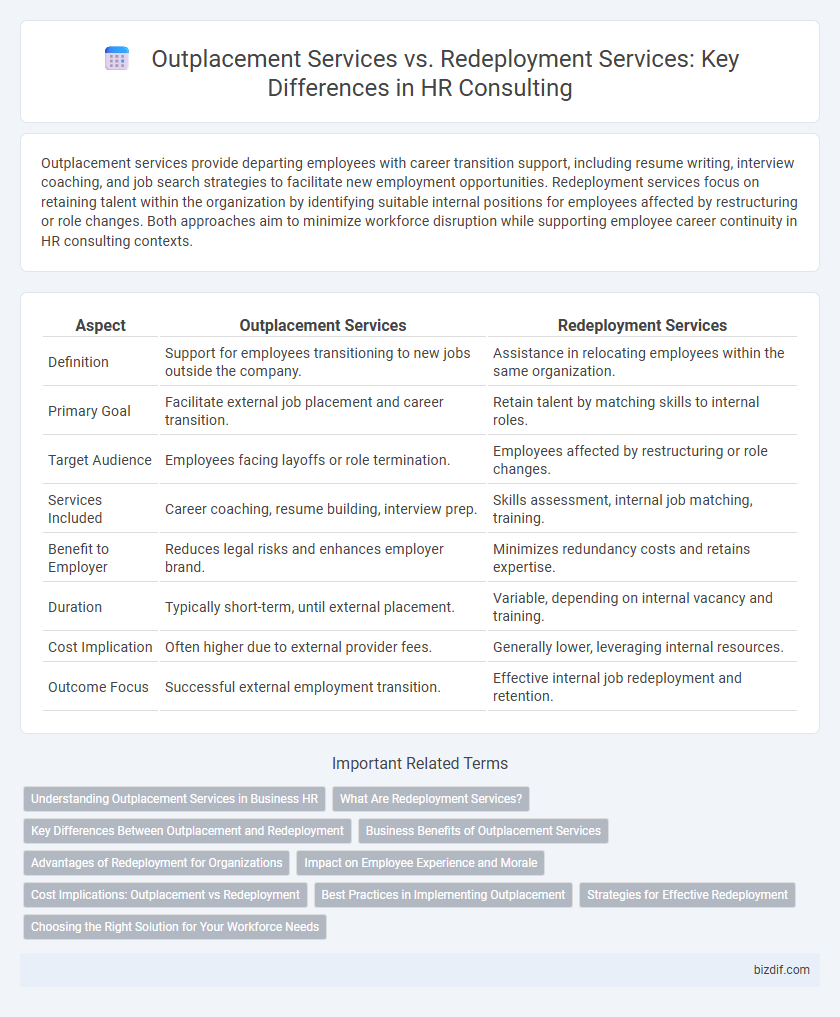Outplacement services provide departing employees with career transition support, including resume writing, interview coaching, and job search strategies to facilitate new employment opportunities. Redeployment services focus on retaining talent within the organization by identifying suitable internal positions for employees affected by restructuring or role changes. Both approaches aim to minimize workforce disruption while supporting employee career continuity in HR consulting contexts.
Table of Comparison
| Aspect | Outplacement Services | Redeployment Services |
|---|---|---|
| Definition | Support for employees transitioning to new jobs outside the company. | Assistance in relocating employees within the same organization. |
| Primary Goal | Facilitate external job placement and career transition. | Retain talent by matching skills to internal roles. |
| Target Audience | Employees facing layoffs or role termination. | Employees affected by restructuring or role changes. |
| Services Included | Career coaching, resume building, interview prep. | Skills assessment, internal job matching, training. |
| Benefit to Employer | Reduces legal risks and enhances employer brand. | Minimizes redundancy costs and retains expertise. |
| Duration | Typically short-term, until external placement. | Variable, depending on internal vacancy and training. |
| Cost Implication | Often higher due to external provider fees. | Generally lower, leveraging internal resources. |
| Outcome Focus | Successful external employment transition. | Effective internal job redeployment and retention. |
Understanding Outplacement Services in Business HR
Outplacement services provide targeted support to employees facing job transitions by offering career counseling, resume building, and interview coaching to facilitate smooth exits and maintain company reputation. These services help businesses uphold employee morale during layoffs while mitigating legal risks and enhancing employer branding. Outplacement differs from redeployment services, which focus on reallocating existing employees within the organization to retain talent and reduce turnover costs.
What Are Redeployment Services?
Redeployment services in HR consulting involve reallocating existing employees to new roles within the same organization to retain talent and reduce layoffs, enhancing workforce stability and cost efficiency. These services include skills assessment, career counseling, and job matching to align employees with suitable positions that fit both their capabilities and organizational needs. Redeployment facilitates smoother transitions and improves employee morale by offering internal opportunities rather than external job searches.
Key Differences Between Outplacement and Redeployment
Outplacement services primarily support employees through career transitions after job termination by offering resume writing, interview coaching, and job search assistance, while redeployment services focus on retaining talent within the organization by identifying internal job opportunities and facilitating employee transfers. Key differences include outplacement's external focus on job market reintegration versus redeployment's internal focus on workforce optimization and talent retention. Outplacement reduces separation-related risks and reputational damage, whereas redeployment minimizes recruitment costs and preserves institutional knowledge.
Business Benefits of Outplacement Services
Outplacement services provide businesses with expert support to smoothly transition employees during layoffs, minimizing legal risks and preserving company reputation. They enhance workforce morale by offering career counseling, resume building, and job search assistance, which reduces the negative impact of redundancies. Investing in outplacement accelerates employee reintegration into the labor market, decreasing unemployment duration and fostering goodwill among remaining staff and clients.
Advantages of Redeployment for Organizations
Redeployment services enhance organizational agility by efficiently reallocating existing talent to new roles, reducing recruitment costs and minimizing downtime. These services strengthen employee retention and morale by providing career continuity within the company, fostering a culture of internal mobility and growth. Leveraging redeployment optimizes workforce capabilities, ensuring critical skills remain aligned with evolving business needs and strategic objectives.
Impact on Employee Experience and Morale
Outplacement services provide structured support such as career counseling and job search assistance, helping employees transition smoothly and preserving their dignity, which positively impacts morale during layoffs. Redeployment services focus on retaining talent by matching employees to new roles within the organization, fostering loyalty and reducing uncertainty that enhances overall employee engagement. Both approaches aim to mitigate the negative effects of workforce changes but differ in their influence on employee experience, with redeployment promoting internal mobility and outplacement supporting external career growth.
Cost Implications: Outplacement vs Redeployment
Outplacement services typically involve higher upfront costs due to personalized career coaching, resume support, and job placement assistance aimed at facilitating smooth employee transitions. Redeployment services often incur lower expenses by focusing on reallocating existing talent within the organization to minimize redundancy and avoid external hiring costs. Evaluating cost implications requires balancing the immediate investment of outplacement against the long-term savings and retention benefits offered by effective redeployment strategies.
Best Practices in Implementing Outplacement
Effective outplacement services prioritize personalized career coaching, resume development, and interview preparation to support departing employees in securing new roles. Integrating psychological support and skill assessments enhances transition success and maintains employer brand reputation. Data-driven program adjustments based on employee feedback and labor market trends optimize outplacement outcomes.
Strategies for Effective Redeployment
Effective redeployment strategies in HR consulting prioritize assessing employee skills, identifying internal vacancies, and aligning talent with organizational needs to minimize layoffs and retain institutional knowledge. Leveraging data-driven workforce analytics enhances matching accuracy, while tailored reskilling programs prepare employees for new roles, boosting retention and productivity. Streamlined communication and continuous support throughout the redeployment process foster employee engagement and facilitate smoother transitions within the company.
Choosing the Right Solution for Your Workforce Needs
Outplacement services provide structured support to employees transitioning out of the company, including career counseling, resume development, and job search assistance, ideal for workforce reductions. Redeployment services focus on internal talent mobility by identifying and reallocating existing employees to new roles within the organization, enhancing retention and reducing hiring costs. Selecting between outplacement and redeployment depends on strategic workforce goals, budget constraints, and the organization's commitment to employee engagement and talent optimization.
Outplacement Services vs Redeployment Services Infographic

 bizdif.com
bizdif.com